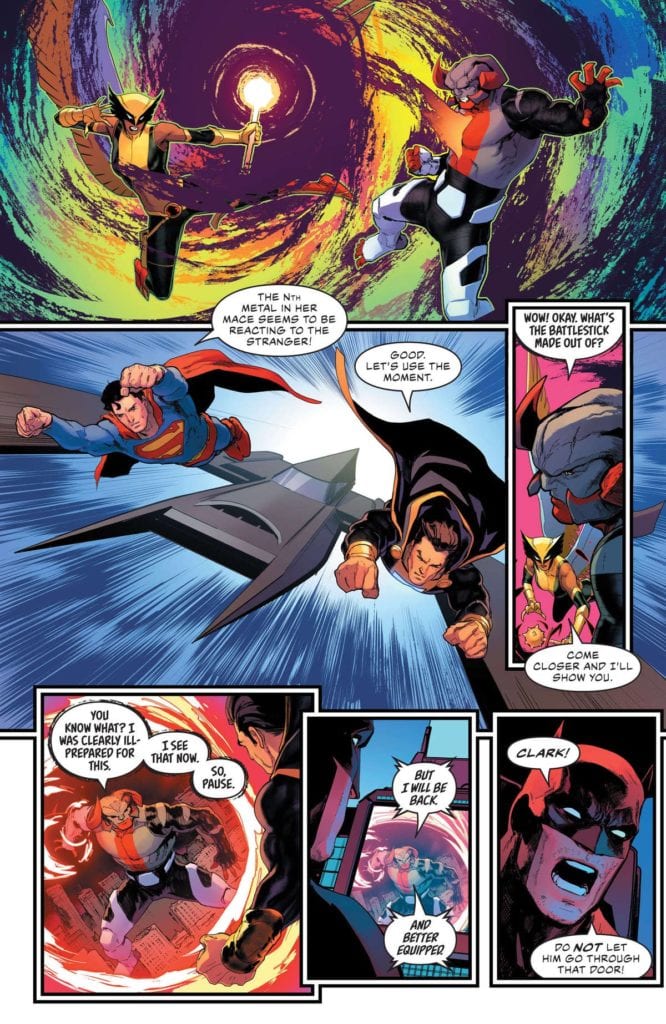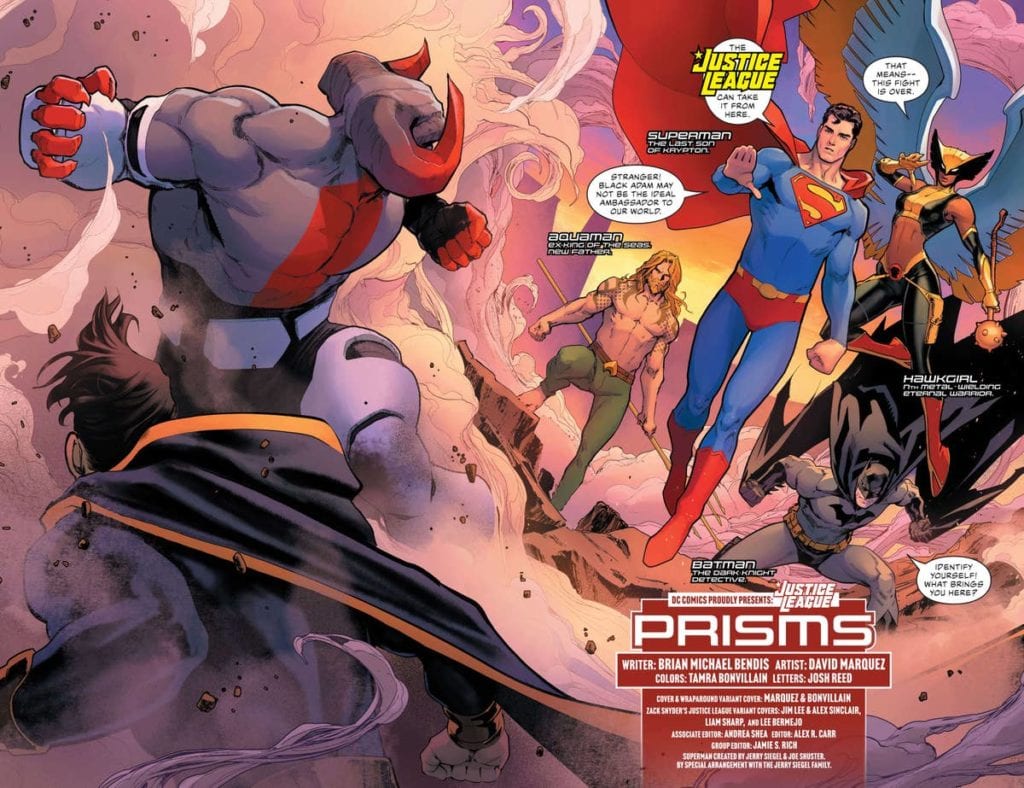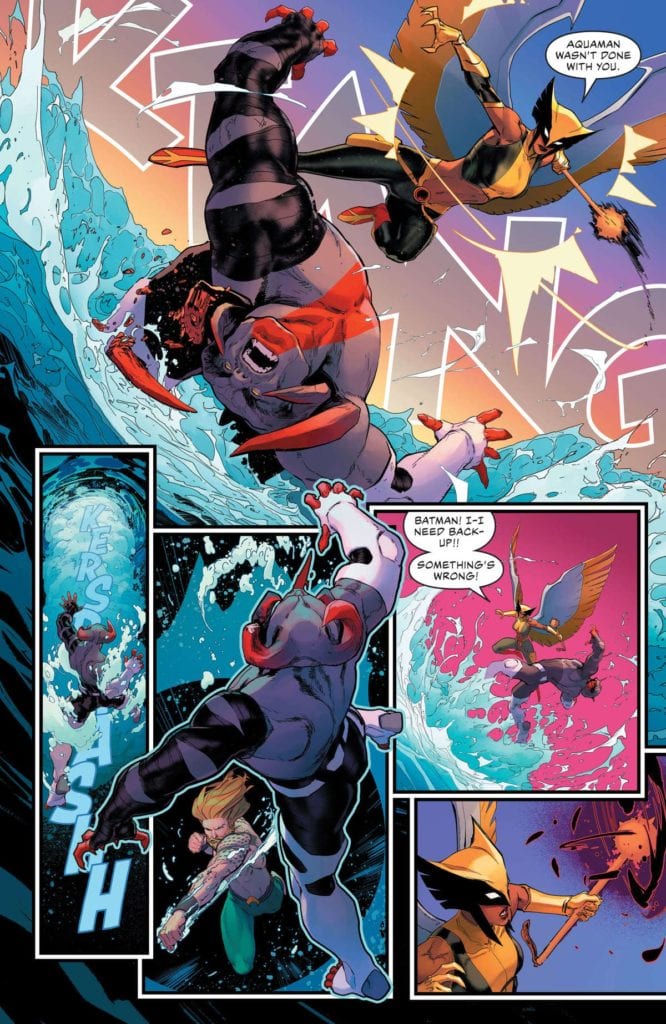Infinite Frontier has launched the DC Universe into a bold new era, and writer Brian Michael Bendis is leading the way with Justice League #59, on sale now. Along with David Marquez, color artist Tamra Bonvillain, and letterer Josh Reed, Bendis takes the team in an exciting new direction and launches a fascinating exploration into the superhero’s complex place in the world.
WRITING
The most compelling aspect of Justice League #59 comes on the first page. While Bendis and Marquez offer a fun, albeit predictable, fight between a mysterious threat and the team’s new line-up, the story hooks the reader on this opening page by diving right into the heart of the matter. Bendis makes it quite clear that his run on this book, at least in the early going, will question what it means to be a superhero.
One could say that this analysis sounds like a tired path to follow, but Bendis offers a fresh twist by contextualizing this examination within the popular understanding of the DCU. However you feel about Zack Snyder’s depiction, he seemingly presented the iconic heroes as genuine gods among men. This presentation also seems to be the foundation for Bendis’ depiction of the Justice League.
On the first page, an unseen narrator (who turns out to be Green Arrow) explains the team’s shortcomings. He states that regular people see heroes as symbols rather than individuals. Queen then argues that Superman’s decision to share his identity to the world made him more relatable and more inherently human.
This theme of relatability is also at the forefront of the book’s first scene. There, Black Adam sympathizes with a young boy whose mother has passed away. On paper, the two characters are drastically different; one is the almighty ruler of Kahndaq, the other is an ordinary child. But Bendis shows how they still manage to connect with each other over a shared experience, as Black Adam is honoring the anniversary of his beloved’s death just as the boy is grieving his own loss.

Bendis captures the striking bond between Black Adam and the child, and it feels like this moment is a small, yet powerful, taste of the question this book will explore: what, if anything, truly separates superheroes from regular people? Based on this first intriguing scene, Bendis is beginning this consideration from a solid position that only stands to improve from here on out.
Don’t worry, there’s still plenty of traditional caped crusader goodness packed into the book. The reader gets to meet the core of the new team — Superman, Aquaman, Batman, and Hawkgirl — before the rest of the group is introduced later on. This quartet, alongside Black Adam, must battle an unstoppable monster, who calls itself Brutus, but what should be a fairly easy fight devolves into a near disaster.

From Hawkgirl’s malfunctioning mace to Aquaman’s inability to match up with the beast, everything goes wrong during the team’s clash with Brutus. The new Justice League is quickly put to the test, and after the fight, the members are left to collectively lick their wounds and ponder the group’s next move. A surprising reveal on the last page also sets up the next step in this story, in which Bendis will bring in one of his original creations from a previous series.
ART
From the start, Marquez and Bonvillain compliment Bendis’ script perfectly. On the first page, Queen’s aforementioned narration is set against the image of the team members combined symbols. Bonvillain uses a gradient for these interconnected icons, from The Flash’s lightning bolt to Superman’s “S”. The top of the page is colored with a shiny gold that captures the flawlessness that’s often associated with superheroes.
But this shiny hue increasingly fades to a dim, subdued orange-bronze at the bottom. This subtle touch hints at the failure that Queen speaks to; the shift in color appropriately begins right when Green Arrow explains that mankind’s inability to understand typical heroes is one of the reasons why the Justice League doesn’t always work. This clear synergy between the art team and the writer is remarkable.

Likewise, Marquez and Bonvillain beautifully depict Kahndaq like a hybrid of Rome and a mythical kingdom. The former utilizes what looks like classical architecture to fuel that comparison to legendary city, while the latter gives the scene a breathtaking purple-orange background that’s right out of a fairytale. This otherworldly tone lines up with the story that’s unfolding on the page, as Black Adam comes across like a magnificent king that one would expect to see in a storybook. The unspoken comparison between superheroes and fairytale characters adds another layer of insight to an already dynamic story.
Brutus’ arrival shatters the innocent tone featured in the first scene. Thanks to the art team, the fearsome beast comes complete with demonic horns and both hellfire and brimstone. It arrives in a burst of flames that disrupts that lovely purple background, creating a strong juxtaposition in the process. For his part, Reed’s letters add to the sense that Brutus isn’t from this world. Unlike every other character, his speech bubbles have a sketchy, rough border, and his text is Bizarro-like because it’s slightly crooked. The eventual confirmation that Brutus comes from an entirely different dimension makes the battle scene even more effective. For the beloved heroes, it’s painfully clear that Brutus is a menace unlike any other.
At this point, Justice League #59 is just the appetizer for Bendis’ work on the book. Fans may be divided over his place as the series’ writer, given his sometimes polarizing work at Marvel. But based on this first outing with these assembled heroes, Bendis has a firm grasp on DC’s most esteemed characters, and he has laid out a fascinating path for them. Plus, having art as beautiful as the combination of Marquez and Bonvillain is a wonderful cherry on top. Any and all Justice League fans should get in on the ground floor of what’s sure to be a memorable run.

